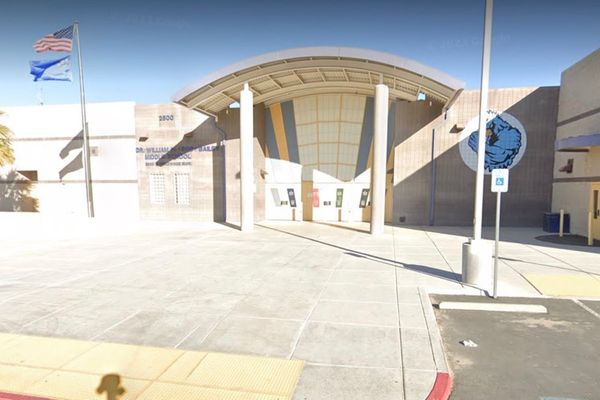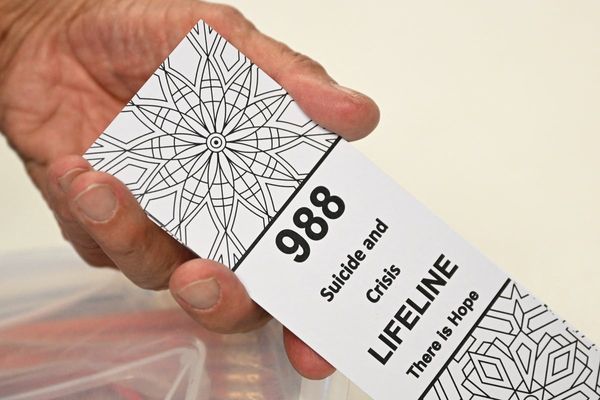
Not long after M Ellen Burns arrived in Kalgoorlie, Western Australia, the state’s borders closed to the rest of Australia and the world for the first time in history. The photographer had been on a road trip from the Blue Mountains to visit her partner’s parents in WA when Covid-19 first began to spread; now she was well and truly stuck. She found work shooting for the town’s tourist board, but a chance meeting with a local barmaid introduced her to the other jewels in Kalgoorlie’s crown: skimpy bars.
Burns photographed several skimpies at work between 2021 and 2023 with their full consent
A “skimpy” is a barmaid who pours pints in lingerie in WA’s mining towns. Usually it’s a fly-in fly-out job, attracting women from all over Australia and beyond. They sign up to agencies, which send them out on a circuit, moving towns every few weeks. The hi-vis of miners, downing schooners at the bars, compete with the electric makeup of the skimpies who dance atop them.
Burns was fascinated: “The rest of the world was in lockdown, but here the party was still going on, so it was kind of surreal.” She started shooting for the socials of Gold Bar and wound up self-publishing a photography book, Skimpies.
Known professionally as “Mellen”, Burns is a retiring type. “I don’t really go out much,” she says. But she gamely got in the thick of things, navigating slippery bar-room floors and boisterous games of “beer pong”, played with a middy glass wedged between a skimpy’s buttocks. It was a world away from her career in Sydney, where she studied photography at the National Art School and worked for portrait photographer Sally Flegg.
Many of the women are Fifo (fly-in fly-out) workers, travelling around some of the most geographically isolated communities in Australia
“Being here made me think about photography in a new way. These candid photos were gold – they’re the essence of what actually happens,” Burns says.
The women Burns immortalised are students, travellers, single mums and young professionals on a lucrative version of spring break. Their interviews, some of which Burns uploaded to SoundCloud, reveal them to have a broad range of views about the demands of the job. Introverted Scarlett describes creating a split personality, with “work Scarlett” graciously accepting roses made out of paper napkins and “home Scarlett” preferring to be alone. Zoe recalls one punter trying to kiss her, “but he doesn’t know that I’m a trained Muay Thai fighter”. Cleo’s interview is sadder, listing awful things that men wearing wedding rings have said to her, “while I serve them yet another drink and cop further and worse verbal, physical, and sexual abuse while the night continues”.
Burns captures the women while they’re on duty; a gloriously chaotic and colourful spillage of limbs, liquids and lingerie. But the first half of the book is dedicated to more sombre portraits of the women, who are dressed in whatever they’d wear on a ciggie break: perhaps an oversized hoodie or man’s shirt. Their faces are still made up, but Burns asked them to look straight down the barrel of the camera, “so that when people read their stories they’re really looking at them”.
Behind the pseudonyms and sequins there’s often an entrepreneurial spirit. A skimpy can earn up to $5,000 on tips on a really good weekend, and there’s often an overlap with fetish modelling and OnlyFans. Many have an online tip jar or are a “party starter” for hire. Some work as life models for local art classes; during the early years of the pandemic, one former skimpy even founded Boober Eats, a takeaway delivery service where out-of-work skimpies delivered food in lingerie.
Burns’ individual portraits of (clockwise) Tilly, Scarlett, Poppy and Cleo
Burns gave the women their own voices in the book and is cautious about speaking on their behalf. She defers to another photographer, Georgie Mattingley, who writes a fascinating essay from the perspective of an artist and former skimpy herself. “This is not just hospitality or customer service; this is an elaborate, emotive and intimate performance,” Mattingley writes. “A highly skilled art form that interweaves gruelling bar work with fantasy and fiction to create a fleeting social world where everyone belongs.”
Has the scene changed much since its genesis in the 1970s? In 2023, feminist activist movement Collective Shout argued “there is no justification for this industry”. Rather than play critic herself, Burns inserted newspaper articles into the book, from the 70s onwards (“They are not naked, they wear shoes,” one publican protests in 1986). But the debate rages on. In 2018, Perth Now reported that the #MeToo movement seemed to have caught up with skimpying, with big corporations eschewing the skimpy pubs where they would usually hold expo functions. “So, are skimpies an anachronism, a relic that demeans women, or are the big city-based companies showing once again the huge and multi-level divide between city and bush?” the journalist asked – to which Mattingley answers in the book: “Only skimpies can make such judgement calls on the industry.”
Some skimpies can earn $5,000 in tips on a good weekend
As Cleo sees it, skimpies “take great care of all the lonely sad men we come across in the pubs”. “In the Perth Museum, you’ll find a section dedicated to the Fifo men who committed suicide due to loneliness,” she adds. “But because of skimpy women, I wonder how many men’s lives have literally been saved.”
Burns, who gave each skimpy her own promo shoot as thanks, now counts many as her friends and Kalgoorlie as her home. “The rhythm is different here, because we’ve got night shift and day shift, on-swing and off-swing. It feels like it’s always grinding away.”
Many of the skimpies Burns interviewed say they love the support they feel from other women in the industry, and the financial freedom the work gave them
It’s hard to imagine skimpying ever being lost in the mists of time. Each year brings a batch of fresh faces and, for some women, Kalgoorlie is like the Hotel California: you can check out any time you like, but you can never leave.
“I’ve only been here for about six months but the place has definitely won my heart really quickly. I can see why people come here and then never leave,” says Poppy, pictured wearing an emerald green robe over a red lace teddy. “I also love being in my undies and so that’s an extra bonus too.”
Skimpies is available to buy from M Ellen Burns’ website
In Australia, support is available at Beyond Blue on 1300 22 4636, Lifeline on 13 11 14, and at MensLine on 1300 789 978. In the UK, the charity Mind is available on 0300 123 3393 and Childline on 0800 1111. In the US, call or text Mental Health America at 988 or chat 988lifeline.org







